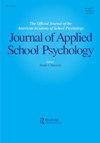Identifying Factors Associated with Patterns of Student Attendance and Participation in a Group Tier 2 Preventive Intervention: Implications for Adaptation
IF 1.5
Q4 PSYCHOLOGY, EDUCATIONAL
引用次数: 9
Abstract
Abstract The extent to which youth attend Tier 2 evidence-based intervention is an important dimension of implementation. This study examined attendance patterns of 369 middle schoolers involved in a randomized trial testing the impact of Coping Power, an evidence-based Tier 2 preventive intervention. We conducted latent profile analysis to examine student attendance at the 25 Coping Power sessions and found three attendance patterns: 69.9% of youth had high and stable attendance, 19.5% of youth had moderate and modestly declining attendance, and 10.6% had poor and sharply declining attendance. We then examined whether students of a particular gender and race or in single-gender/race intervention groups were more likely to demonstrate certain attendance patterns and whether there were mean differences across attendance patterns on student behavioral risk, affect, and group engagement, group characteristics (e.g., group behavioral norms), and individual contacts with the group leader. Analyses indicated students demonstrating the poor and sharply declining attendance pattern had higher early-session negative affect than students with the other two attendance patterns and were less likely to be in gender-balanced groups than students with moderate and modestly declining attendance. Students with moderate and modestly declining attendance spent more time in contacts with group leaders than students with high and stable attendance. Students with high attendance were in groups with the highest early-session group attendance rates. Implications of these findings for adaptation and tailoring of the Tier 2 Coping Power program are discussed.识别与学生出勤和参与团体二级预防干预模式相关的因素:对适应的影响
摘要青年参加二级循证干预的程度是实施的一个重要方面。这项研究调查了369名中学生的出勤模式,他们参与了一项随机试验,测试应对能力的影响,这是一种基于证据的二级预防干预措施。我们进行了潜在概况分析,以检查学生在25次应对能力课程中的出勤率,发现了三种出勤模式:69.9%的年轻人出勤率高且稳定,19.5%的年轻人的出勤率中等且适度下降,10.6%的学生出勤率低且急剧下降。然后,我们研究了特定性别和种族的学生或单一性别/种族干预组的学生是否更有可能表现出特定的出勤模式,以及在学生行为风险、影响和群体参与、群体特征(例如,群体行为规范)以及个人与组长的接触方面,出勤模式之间是否存在平均差异。分析表明,表现出出勤率低且急剧下降的学生比表现出其他两种出勤率模式的学生有更高的早期负面影响,并且与出勤率中等或适度下降的学生相比,不太可能处于性别平衡的群体中。出勤率中等和适度下降的学生比出勤率高和稳定的学生花更多的时间与组长联系。出勤率高的学生属于早课出勤率最高的组。讨论了这些发现对二级应对能力计划的适应和调整的影响。
本文章由计算机程序翻译,如有差异,请以英文原文为准。
求助全文
约1分钟内获得全文
求助全文
来源期刊

Journal of Applied School Psychology
PSYCHOLOGY, EDUCATIONAL-
CiteScore
2.40
自引率
10.00%
发文量
7
期刊介绍:
With a new publisher (Taylor & Francis) and a new editor (David L. Wodrich), the Journal of Applied School Psychology will continue to publish articles and periodic thematic issues in 2009. Each submission should rest on either solid theoretical or empirical support and provide information that can be used in applied school settings, related educational systems, or community locations in which practitioners work. Manuscripts appropriate for publication in the journal will reflect psychological applications that pertain to individual students, groups of students, teachers, parents, and administrators. The journal also seeks, over time, novel and creative ways in which to disseminate information about practically sound and empirically supported school psychology practice.
 求助内容:
求助内容: 应助结果提醒方式:
应助结果提醒方式:


